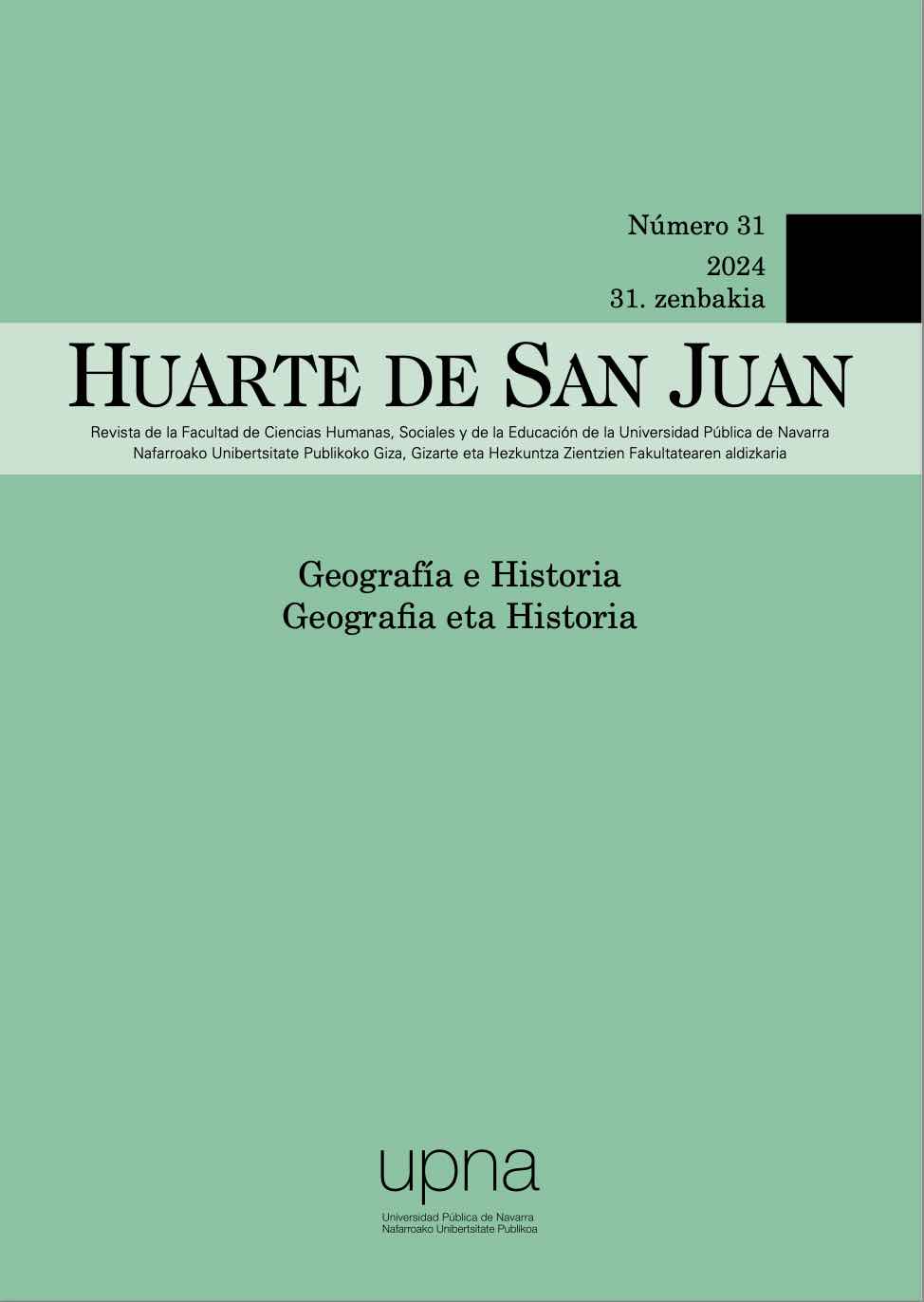Grafitos y autores invisibles. Los grafitos figurativos del Royal Cachette wadi (Luxor, Egipto) como estudios de caso
DOI:
https://doi.org/10.48035/rhsj-gh.31.3Palabras clave:
grafitos, figurativos, invisibilidad, Royal Cachette wadi, EgiptoResumen
Los grafitos figurativos realizados por las culturas antiguas pueden ser considerados como una fuente de información de los sectores más bajos de la sociedad, gentes iletradas incapaces de producir textos escritos, y también reflejo de una población mayoritariamente analfabeta. Los autores invisibles de esos dibujos nos han legado una evidencia compleja, pero que resulta una excepcional muestra del deseo de dejar constancia de su presencia en un lugar. A partir de dos estudios de caso de grafitos figurativos del llamado Royal Cachette wadi o wadi C2 en la antigua Tebas (Luxor, Egipto), se plantea un análisis holístico que tenga en cuenta su iconografía, su función y la ubicación exacta en el contexto del paisaje. Todo ello servirá para mostrar la importancia del wadi C2, el carácter liminal de la ubicación de ambos grafitos y el papel sagrado del lugar que presenta una excepcional concentración de grafitos en el contexto de la montaña tebana.
Descargas
Citas
Allon, Niv, y Hana Navratilova, Scribal Culture in Ancient Egypt, Cambridge, Cambridge University Press, 2023.
Assmann, Jan, «Communicative and Cultural Memory», en Astrid Erll y Ansgar Nünning (eds.), Cultural Memory Studies. An International and Interdisciplinary Handbook, Berlín/ Nueva York, De Gruyter, 2008, pp. 109-118.
Babcock, Jennifer Miyuki, «Curated Desertscapes in Ancient Egyptian Tombs and Investigating Iconographies of the Wild», Arts, 11, 2022, p. 59. doi: https://doi.org/10.3390/arts11030059.
Baines, John «Literacy and Ancient Egyptian Society», Man, New Series, 18.3, 1983, pp. 572-599.
Candelas Fisac, Juan, «Presence of lithic industry in the Wadi C2 at West Thebes», en Helena Trindade y André Patricio (eds.), In thy arms I lost myself: Images, Perceptions and Productions in/of Antiquity, Cambridge, Cambridge Scholarly Publishers, 2023, pp. 20-36.
Červíček, Pavel, Felsbilder des Nord-Etbai, Oberägyptens und Unternubiens. Ergebnisse der Frobenius-Expeditionen, 16, Wiesbaden, Steiner, 1974.
Davies, Norman de Garis, Allan Gardiner, y Nina de Garis Davies, The tomb of Antefoker, vizier of Sésostris I and of his wife Senet, The Theban Tombs Series Second Memoir, Londres, Egypt Exploration Society, 1920.
Davies, Nina de Garis, The Tomb of Rekh-mi-Re’ at Thebes, Nueva York, Publications of the Metropolitan Museum of Art, 1943.
Darnell, John Colemann, «Iconographic Attraction, Iconographic Syntax, and Tableaux of Royal Ritual Power in the Pre- and Proto-Dynastic Rock Inscriptions of the Theban Western Desert», ArcheoNil, 19, 2009, pp. 83-107.
Dorn, Andreas, «Graffiti in Western Thebes left by the members of the Community of Workmen and others: Past research, future perspectives and a recently identified Eighteenth Dynasty graffito», en Benedict G. Davies (ed.), Dispatches from Deir el Medina, Wallasey Abercrombie Press, 2023, pp. 91-108.
Evans, Linda, Animal Behaviour in Egyptian Art (The Australian Centre for Egyptology, Studies 9), Oxford, Aris and Phillips, 2010.
Gilroy, Thomas, «Outlandish Outlanders: Foreigners and Caricature in Egyptian Art», Göttinger Miszellen, 191, 2002, pp. 35-52.
Hendrickx, Stan, «L’iconographie de la chasse dans le contexte social prédynastique», Archéo-Nil, 20, 2010, pp. 106-133.
Hendrickx, Stan, «The dog, the Lycaon pictus and order over chaos in Predynastic Egypt», en Karla Kroeper, Marek Chodnicki y Michal Kobusiewicz (eds.), Archaeology of Early Northeastern Africa. In Memory of Lech Krzyaniak, Studies in African Archaeology 9, Poznan, Poznan Archaeological Museum, 2006, pp. 723-749
Huyghe, Dirk, y Wouter Claes, «Arte rupestre gravé paleolithique de Haute Egypté: El-Hosh et Qurta», Bulletin de l’Association Scientifique Liégeoise pour la Recherche Archéologique», xxviii, 2013-2015, pp. 21-39.
Jacquet-Gordon, Helen, Graffiti on the Khonsu Temple Roof, Chicago, Oriental Institute Publications, 2003.
Lesko, Leonard, «Literacy», en Donald Redford (ed.), The Oxford Encyclopedia of Ancient Egypt, II, Oxford/Nueva York, Oxford University Press, 2001, pp. 297-299.
Martin, Geoffrey Thorndike, The Memphite Tomb of Horemheb, Commander-in-Chief of Tutankhamun, I: reliefs and inscriptions, Londres, Egypt Exploration Society, 1989.
Morgan, Lyvia, «Art and International Relations: the Hunt Frieze at Tell el Dab’a», en Ernst Czerny et al. (eds.), Timelines: Studies in Honour of Manfred Bietak II (OLA 149), Lovaina, Peeters, 2006, pp. 249-258.
Muñoz Herrera, Antonio, «Digitalization of the Graffiti in the Royal Cache Wadi: The C2 Method», en Ola el-Aguizy y Burt Kasparian (eds), ICE XII. Proceedings of the Twelfth International Congress of Egyptologists, 3rd-8th November 2019, Bibliothèque générale 71, Cairo, Institut Français d’Archéologie Orientale Publications, 2023, pp. 927-936.
Pérez-Accino, José Ramón, y Hisham el-Leithy, «C2 Project: The Royal Cache Wadi Survey – 2017 Season», Trabajos de Egiptología/Papers in Egyptology, 10, 2019, pp. 305-314.
Pérez-Accino, José Ramón, Hisham el-Leithy, «Newest Research in the Royal Cache Wadi, Luxor: The C2 Project», en Ola el-Aguizy y Burt Kasparian (eds.), ICE XII. Proceedings of the Twelfth International Congress of Egyptologists, 3rd-8th November 2019, Bibliothèque générale 71, Cairo, Institut Français d’Archéologie Orientale Publications, 2023, pp 289-296.
Pérez-Accino, José Ramón, Inmaculada Vivas Sainz, y Antonio Muñoz Herrera, «The embracing mountain: newest research in the Royal Cachette wadi, Luxor West Bank», en Helena Trindade y André Patricio (eds.), In thy arms I lost myself: Images, Perceptions and Productions in/of Antiquity, Cambridge, Cambridge Scholarly Publishers, 2023, pp. 100-114
Pérez Largacha, Antonio, «Algunas reflexiones sobre Gilf Kebir, el desierto Occidental y los orígenes de la cultura egipcia», Boletín de la Asociación Española de Egiptología, 24, 2015, pp. 89-110.
Ragab, Muhammad, «Transformation of a Sacred Landscape: Veneration of Amun-Re in Graffiti in the Valley of the Kings», Journal of Egyptian Archaeology, 107, 1-2, 2021, pp. 191-205. doi: https://doi.org/10.1177/03075133211032235.
Ragazzoli, Chloé, «The social creation of a scribal place: The visitors’ inscriptions in the tomb attributed to Antefiqer (tt 60), with newly recorded graffiti», Studien zur Altägyptischen Kultur, 42, 2013, pp. 269-323.
Rzepka, Slawomir, Who, where and why: the rock graffiti of members of the Deir el-Medina community, Varsovia, University of Warsaw, 2014.
Sadek, Abdel Aziz, Graffiti de la Montagne Thébaine, IV, 4, Cairo, CEDAE Publications, 1973.
Sadek, Abdel Aziz, y Mohammed Shimy, Graffiti de la Montagne Thébaine, III, 6, Cairo CEDAE Publications, 1974.
Spiegelberg, Wilmhelm, Ägyptische und andere Graffiti (Inschriften und Zeichnungen) aus der Thebanischen Nekropolis. Text und Atlas, Heidelberg, Heidelberg Carl Winter, 1921.
Strandberg, Åsa, The Gazelle in Ancient Egyptian Art: Image and Meaning, Uppsala, Uppsala University, 2009.
Vivas Sainz, Inmaculada, «Graffitis en la zona tebana: contexto sagrado e intencionalidad en los graffitis figurativos del Royal Cache Wadi Survey», Trabajos de Egiptología/ Papers in Egyptology, 10, 2019, pp. 403-419.
Vivas Sainz, Inmaculada, «An unusual graffito in the Cachette Wadi. Hunting in the desert boundary? Meaning, function and authorship», en Ola el-Aguizy, y Burt Kasparian (eds), ICE XII. Proceedings of the Twelfth International Congress of Egyptologists, 3rd-8th November 2019, Bibliothèque générale 71, Cairo, Institut Français d’Archéologie Orientale Publications, 2023, pp. 527-534.
Descargas
Publicado
Cómo citar
Número
Sección
Licencia
Derechos de autor 2024 Inmaculada Vivas Sainz

Esta obra está bajo una licencia internacional Creative Commons Atribución-NoComercial-SinDerivadas 4.0.
La información referente al sistema de autoarchivo y política de derechos de explotación establecido por esta revista puede consultarse en DULCINEA.








